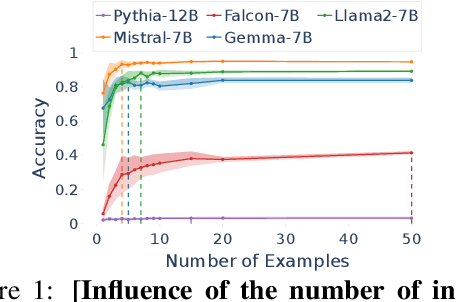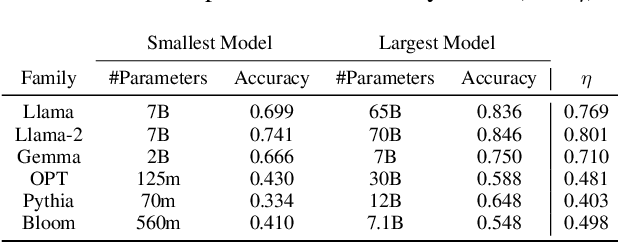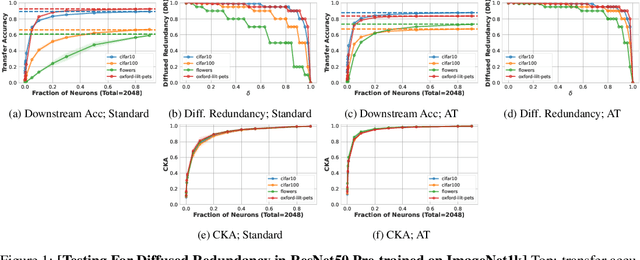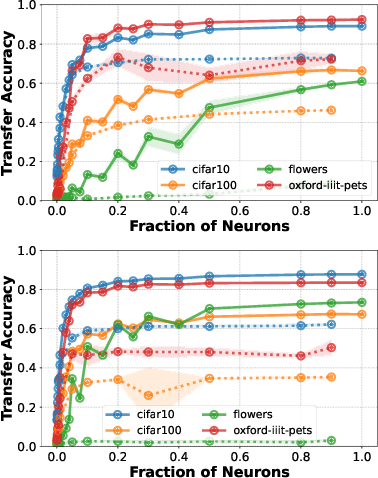Krishna P. Gummadi
MPI-SWS
Hubble: a Model Suite to Advance the Study of LLM Memorization
Oct 22, 2025Abstract:We present Hubble, a suite of fully open-source large language models (LLMs) for the scientific study of LLM memorization. Hubble models come in standard and perturbed variants: standard models are pretrained on a large English corpus, and perturbed models are trained in the same way but with controlled insertion of text (e.g., book passages, biographies, and test sets) designed to emulate key memorization risks. Our core release includes 8 models -- standard and perturbed models with 1B or 8B parameters, pretrained on 100B or 500B tokens -- establishing that memorization risks are determined by the frequency of sensitive data relative to size of the training corpus (i.e., a password appearing once in a smaller corpus is memorized better than the same password in a larger corpus). Our release also includes 6 perturbed models with text inserted at different pretraining phases, showing that sensitive data without continued exposure can be forgotten. These findings suggest two best practices for addressing memorization risks: to dilute sensitive data by increasing the size of the training corpus, and to order sensitive data to appear earlier in training. Beyond these general empirical findings, Hubble enables a broad range of memorization research; for example, analyzing the biographies reveals how readily different types of private information are memorized. We also demonstrate that the randomized insertions in Hubble make it an ideal testbed for membership inference and machine unlearning, and invite the community to further explore, benchmark, and build upon our work.
Rote Learning Considered Useful: Generalizing over Memorized Data in LLMs
Jul 29, 2025Abstract:Rote learning is a memorization technique based on repetition. It is commonly believed to hinder generalization by encouraging verbatim memorization rather than deeper understanding. This insight holds for even learning factual knowledge that inevitably requires a certain degree of memorization. In this work, we demonstrate that LLMs can be trained to generalize from rote memorized data. We introduce a two-phase memorize-then-generalize framework, where the model first rote memorizes factual subject-object associations using a semantically meaningless token and then learns to generalize by fine-tuning on a small set of semantically meaningful prompts. Extensive experiments over 8 LLMs show that the models can reinterpret rote memorized data through the semantically meaningful prompts, as evidenced by the emergence of structured, semantically aligned latent representations between the two. This surprising finding opens the door to both effective and efficient knowledge injection and possible risks of repurposing the memorized data for malicious usage.
Revisiting Privacy, Utility, and Efficiency Trade-offs when Fine-Tuning Large Language Models
Feb 18, 2025Abstract:We study the inherent trade-offs in minimizing privacy risks and maximizing utility, while maintaining high computational efficiency, when fine-tuning large language models (LLMs). A number of recent works in privacy research have attempted to mitigate privacy risks posed by memorizing fine-tuning data by using differentially private training methods (e.g., DP), albeit at a significantly higher computational cost (inefficiency). In parallel, several works in systems research have focussed on developing (parameter) efficient fine-tuning methods (e.g., LoRA), but few works, if any, investigated whether such efficient methods enhance or diminish privacy risks. In this paper, we investigate this gap and arrive at a surprising conclusion: efficient fine-tuning methods like LoRA mitigate privacy risks similar to private fine-tuning methods like DP. Our empirical finding directly contradicts prevailing wisdom that privacy and efficiency objectives are at odds during fine-tuning. Our finding is established by (a) carefully defining measures of privacy and utility that distinguish between memorizing sensitive and non-sensitive tokens in training and test datasets used in fine-tuning and (b) extensive evaluations using multiple open-source language models from Pythia, Gemma, and Llama families and different domain-specific datasets.
Understanding Memorisation in LLMs: Dynamics, Influencing Factors, and Implications
Jul 27, 2024Abstract:Understanding whether and to what extent large language models (LLMs) have memorised training data has important implications for the reliability of their output and the privacy of their training data. In order to cleanly measure and disentangle memorisation from other phenomena (e.g. in-context learning), we create an experimental framework that is based on repeatedly exposing LLMs to random strings. Our framework allows us to better understand the dynamics, i.e., the behaviour of the model, when repeatedly exposing it to random strings. Using our framework, we make several striking observations: (a) we find consistent phases of the dynamics across families of models (Pythia, Phi and Llama2), (b) we identify factors that make some strings easier to memorise than others, and (c) we identify the role of local prefixes and global context in memorisation. We also show that sequential exposition to different random strings has a significant effect on memorisation. Our results, often surprising, have significant downstream implications in the study and usage of LLMs.
Sponsored is the New Organic: Implications of Sponsored Results on Quality of Search Results in the Amazon Marketplace
Jul 26, 2024



Abstract:Interleaving sponsored results (advertisements) amongst organic results on search engine result pages (SERP) has become a common practice across multiple digital platforms. Advertisements have catered to consumer satisfaction and fostered competition in digital public spaces; making them an appealing gateway for businesses to reach their consumers. However, especially in the context of digital marketplaces, due to the competitive nature of the sponsored results with the organic ones, multiple unwanted repercussions have surfaced affecting different stakeholders. From the consumers' perspective the sponsored ads/results may cause degradation of search quality and nudge consumers to potentially irrelevant and costlier products. The sponsored ads may also affect the level playing field of the competition in the marketplaces among sellers. To understand and unravel these potential concerns, we analyse the Amazon digital marketplace in four different countries by simulating 4,800 search operations. Our analyses over SERPs consisting 2M organic and 638K sponsored results show items with poor organic ranks (beyond 100th position) appear as sponsored results even before the top organic results on the first page of Amazon SERP. Moreover, we also observe that in majority of the cases, these top sponsored results are costlier and are of poorer quality than the top organic results. We believe these observations can motivate researchers for further deliberation to bring in more transparency and guard rails in the advertising practices followed in digital marketplaces.
Understanding the Role of Invariance in Transfer Learning
Jul 05, 2024Abstract:Transfer learning is a powerful technique for knowledge-sharing between different tasks. Recent work has found that the representations of models with certain invariances, such as to adversarial input perturbations, achieve higher performance on downstream tasks. These findings suggest that invariance may be an important property in the context of transfer learning. However, the relationship of invariance with transfer performance is not fully understood yet and a number of questions remain. For instance, how important is invariance compared to other factors of the pretraining task? How transferable is learned invariance? In this work, we systematically investigate the importance of representational invariance for transfer learning, as well as how it interacts with other parameters during pretraining. To do so, we introduce a family of synthetic datasets that allow us to precisely control factors of variation both in training and test data. Using these datasets, we a) show that for learning representations with high transfer performance, invariance to the right transformations is as, or often more, important than most other factors such as the number of training samples, the model architecture and the identity of the pretraining classes, b) show conditions under which invariance can harm the ability to transfer representations and c) explore how transferable invariance is between tasks. The code is available at \url{https://github.com/tillspeicher/representation-invariance-transfer}.
Investigating Nudges toward Related Sellers on E-commerce Marketplaces: A Case Study on Amazon
Jul 01, 2024



Abstract:E-commerce marketplaces provide business opportunities to millions of sellers worldwide. Some of these sellers have special relationships with the marketplace by virtue of using their subsidiary services (e.g., fulfillment and/or shipping services provided by the marketplace) -- we refer to such sellers collectively as Related Sellers. When multiple sellers offer to sell the same product, the marketplace helps a customer in selecting an offer (by a seller) through (a) a default offer selection algorithm, (b) showing features about each of the offers and the corresponding sellers (price, seller performance metrics, seller's number of ratings etc.), and (c) finally evaluating the sellers along these features. In this paper, we perform an end-to-end investigation into how the above apparatus can nudge customers toward the Related Sellers on Amazon's four different marketplaces in India, USA, Germany and France. We find that given explicit choices, customers' preferred offers and algorithmically selected offers can be significantly different. We highlight that Amazon is adopting different performance metric evaluation policies for different sellers, potentially benefiting Related Sellers. For instance, such policies result in notable discrepancy between the actual performance metric and the presented performance metric of Related Sellers. We further observe that among the seller-centric features visible to customers, sellers' number of ratings influences their decisions the most, yet it may not reflect the true quality of service by the seller, rather reflecting the scale at which the seller operates, thereby implicitly steering customers toward larger Related Sellers. Moreover, when customers are shown the rectified metrics for the different sellers, their preference toward Related Sellers is almost halved.
Towards Reliable Latent Knowledge Estimation in LLMs: In-Context Learning vs. Prompting Based Factual Knowledge Extraction
Apr 19, 2024



Abstract:We propose an approach for estimating the latent knowledge embedded inside large language models (LLMs). We leverage the in-context learning (ICL) abilities of LLMs to estimate the extent to which an LLM knows the facts stored in a knowledge base. Our knowledge estimator avoids reliability concerns with previous prompting-based methods, is both conceptually simpler and easier to apply, and we demonstrate that it can surface more of the latent knowledge embedded in LLMs. We also investigate how different design choices affect the performance of ICL-based knowledge estimation. Using the proposed estimator, we perform a large-scale evaluation of the factual knowledge of a variety of open source LLMs, like OPT, Pythia, Llama(2), Mistral, Gemma, etc. over a large set of relations and facts from the Wikidata knowledge base. We observe differences in the factual knowledge between different model families and models of different sizes, that some relations are consistently better known than others but that models differ in the precise facts they know, and differences in the knowledge of base models and their finetuned counterparts.
Antitrust, Amazon, and Algorithmic Auditing
Mar 27, 2024



Abstract:In digital markets, antitrust law and special regulations aim to ensure that markets remain competitive despite the dominating role that digital platforms play today in everyone's life. Unlike traditional markets, market participant behavior is easily observable in these markets. We present a series of empirical investigations into the extent to which Amazon engages in practices that are typically described as self-preferencing. We discuss how the computer science tools used in this paper can be used in a regulatory environment that is based on algorithmic auditing and requires regulating digital markets at scale.
Diffused Redundancy in Pre-trained Representations
May 31, 2023



Abstract:Representations learned by pre-training a neural network on a large dataset are increasingly used successfully to perform a variety of downstream tasks. In this work, we take a closer look at how features are encoded in such pre-trained representations. We find that learned representations in a given layer exhibit a degree of diffuse redundancy, i.e., any randomly chosen subset of neurons in the layer that is larger than a threshold size shares a large degree of similarity with the full layer and is able to perform similarly as the whole layer on a variety of downstream tasks. For example, a linear probe trained on $20\%$ of randomly picked neurons from a ResNet50 pre-trained on ImageNet1k achieves an accuracy within $5\%$ of a linear probe trained on the full layer of neurons for downstream CIFAR10 classification. We conduct experiments on different neural architectures (including CNNs and Transformers) pre-trained on both ImageNet1k and ImageNet21k and evaluate a variety of downstream tasks taken from the VTAB benchmark. We find that the loss & dataset used during pre-training largely govern the degree of diffuse redundancy and the "critical mass" of neurons needed often depends on the downstream task, suggesting that there is a task-inherent redundancy-performance Pareto frontier. Our findings shed light on the nature of representations learned by pre-trained deep neural networks and suggest that entire layers might not be necessary to perform many downstream tasks. We investigate the potential for exploiting this redundancy to achieve efficient generalization for downstream tasks and also draw caution to certain possible unintended consequences.
 Add to Chrome
Add to Chrome Add to Firefox
Add to Firefox Add to Edge
Add to Edge